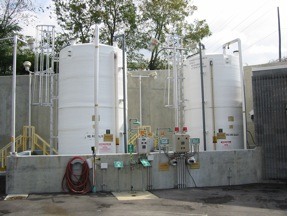Iron Salts Addition
Iron Salts are a chemical treatment for wastewater, often added to wastewater collection systems upstream from treatment plant influent to control hydrogen sulfide emissions. They include Ferrous Chloride, Ferrous Sulfate and Ferric Chloride. Iron Salts are precipitants that oxidize and precipitate dissolved sulfides in wastewater to form iron sulfides. The iron sulfides are insoluble and cannot be stripped from the wastewater.
Iron Salts are typically dosed with metering pumps upstream of treatment plants or at pumping stations. The dosage is usually in proportion to flow and dissolved sulfide concentrations, or as required to control hydrogen sulfide emissions. Dosages may vary seasonally. The chemicals are normally stored in FRP or HDPE tanks and require secondary containment, since they are corrosive and may be considered hazardous. Depending on the dilution ratio, iron salts may have a relatively high freezing point (28°F) and freeze protection is commonly provided.
Iron Salts are relatively inexpensive, but require special handling due to the highly corrosive nature. Protective clothing, gloves, and goggles are recommended when handling the chemicals. Iron Salts can be the lowest cost chemical (other than liquid oxygen) used for odor control because they are a waste by-product of the steel industry. However, they generally require significantly higher dosages than other alternatives, such as calcium nitrate. Iron Salts have a practical treatment limit of down to approximately 0.5 mg/L dissolved sulfides, as compared to a practical treatment limit of approximately 0.1 mg/L dissolved sulfides for calcium nitrate.
PRI-SC
Providers have introduced a chemical treatment technology several years ago that combines iron salts with hydrogen peroxide for hydrogen sulfide control. The technology is called “Peroxide Regenerated Iron – Sulfide Control” (PRI-SC). Iron salts are used as the primary sulfide control chemical and the hydrogen peroxide is used to regenerate the iron from the spent iron salts. Typically, the iron salts are added at the lift station and the hydrogen peroxide is added at intermediate points downstream in the force main, particularly close to the discharge location. The hydrogen peroxide is added to regenerate the iron salts and to oxidize residual hydrogen sulfide. U.S. Peroxide claims an advantage to this technology is the chemical dosages and resulting chemical costs may be reduced over either iron salts or hydrogen peroxide alone.
Applicable Treatment Processes
Pump Stations, treatment plant headworks.
Major Design Considerations
Location of injection
Iron salts are commonly injected just upstream from wastewater treatment plants to enhance precipitation in the plant processes and decrease hydrogen sulfide loadings at the plant. They are also fed at pumping stations to mitigate hydrogen sulfide release at air release valves and force main discharge structures.
Special Handling
The chemical requires storage tanks with secondary containment because it is a hazardous chemical which is highly corrosive, therefore appropriate site location must be considered. Freeze protection may be required depending on the climate and the dilution ratio of the chemical being provided.
Metals
Iron salts commonly contain traces of other metals that will settle out in the biosolids at wastewater treatment plants. These metals could affect biosolids disposal options or create a permitting issue.
Turbidity
Iron salts will turn the wastewater black.
UV
Iron salts will form a film on ultraviolet light disinfection bulbs and cause them to lose efficiency. Iron salts are not recommended upstream of plants that use UV disinfection.

